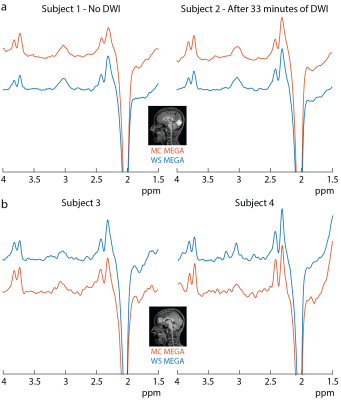Kimberly Chan1, Andreas Hock2, Richard Edden3,4, Erin MacMillan5, and Anke Henning1,6
1The University of Texas Southwestern, Dallas, TX, United States, 2MR Clinical Science, Philips Health Systems, Horgen, Switzerland, 3Russell H. Morgan Department of Radiology and Radiological Science, The Johns Hopkins University School of Medicine, Baltimore, MD, United States, 4. M. Kirby Research Center for Functional Brain Imaging, Kennedy Krieger Institute, Baltimore, MD, United States, 5UBC MRI Research Centre, University of British Columbia, Vancouver, BC, Canada, 6Max Planck Institute for Biological Cybernetics, Tübingen, Germany
1The University of Texas Southwestern, Dallas, TX, United States, 2MR Clinical Science, Philips Health Systems, Horgen, Switzerland, 3Russell H. Morgan Department of Radiology and Radiological Science, The Johns Hopkins University School of Medicine, Baltimore, MD, United States, 4. M. Kirby Research Center for Functional Brain Imaging, Kennedy Krieger Institute, Baltimore, MD, United States, 5UBC MRI Research Centre, University of British Columbia, Vancouver, BC, Canada, 6Max Planck Institute for Biological Cybernetics, Tübingen, Germany
Metabolite cycling is combined with J-difference editing to allow for continuous prospective frequency correction without additional acquisitions to reduce B0 field instability and macromolecule (MM) contamination in MM-suppressed GABA-editing.

3. (a) Voxel location in the OCC and example spectra in two different subjects acquired with and without prior DWI. In both cases, the WS-MEGA and MC-MEGA spectra are qualitatively similar to one another. (b) Voxel location in the medial prefrontal cortex and example spectra in two subjects. In one case, the WS-MEGA spectrum displays a significantly larger Cho artifact than the MC-MEGA spectrum.

4. Metrics of the water frequency across subjects. (a) Boxplots comparing the magnitude average ΔF0 between the MC-MEGA and WS-MEGA scans. The average ΔF0 is 68% lower in the MC-MEGA scans than in the WS-MEGA scans in the OCC. In the mPFC, the average ΔF0 is 65% lower in the MC-MEGA scans than in the WS-MEGA scans (b) Boxplots comparing the standard deviation of the water frequency between WS-MEGA and MC-MEGA experiments. The water frequency standard deviation is 26% lower in the MC-MEGA scans than in the WS-MEGA scans in the OCC and 75% lower in the MC-MEGA scans than in the WS-MEGA in the mPFC.